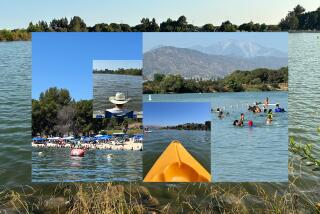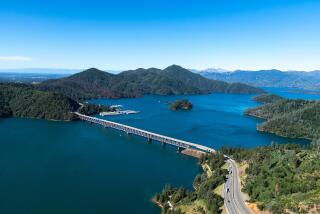Crowd Drought Over at Lake Casitas : Recreation: As water level has risen, so has attendance at the resort near Ojai. More than a million visitors are expected this year.
In the midst of the drought, the water level at Lake Casitas dropped so low that a lone tree poked up out of the water as a constant reminder of the dry spell.
The number of visitors to the lake near Ojai plummeted as well, but now that the lake is full again, the numbers are soaring. During March, an estimated 82,000 people used the lake--20,000 more than March of last year.
“It’s been packed,” park services manager Doug Ralph said. “And April will be bigger than March.”
Ralph anticipates that visitor numbers at the lake this year will top 1 million for the first time since 1986, the last time the lake was full.
Last weekend, cars towing boats and recreational vehicles filled up the lake’s 460 campsites, and park rangers began diverting visitors into a grassy overflow camping area.
Among them was veteran angler Lynn Stabler, who remembers what the fishing was like when the water level was down 65 feet.
“It was terrible,” she said. “It’s nice to see it like this again.”
It was midmorning, and people sat around picnic tables drinking coffee, children bicycled nearby, and a stream of trailers unloaded boats to cruise the lake’s 35 miles of shoreline. Despite the numbers, it was quiet.
“To me this is escape,” said Stabler, who lives in Van Nuys. “I’d rather listen to the frogs and the crickets. It’s absolutely beautiful.”
The scene at Lake Piru, near Fillmore, was not too different.
“Our campground has been full every weekend since early March,” said Doug West, park manager at the smaller Lake Piru. Day use is running at 90% to 95% of capacity, he said.
The water level has made a big difference, West said. Two years ago, the lake was down 80 feet because of the drought.
“It looked like the moon,” he said. “People really feel when it’s down, it’s not attractive, it’s aesthetically displeasing.”
Because of the rains in 1992, the lake was full by last summer. But already this year, visitor numbers are up 20% to 25% over last year, he said.
And because the water is up, the fishing is better. “This is probably the finest fishing I’ve seen in 15 years,” West said.
But it is not just the water level that is drawing crowds to the two lakes, officials at both lakes agree. The recession has a lot to do with it. With less money, people vacation and recreate closer to home. And a weekend camping at Lake Casitas or Lake Piru is cheaper than a motel.
“We’re a tank of gas from Los Angeles,” Ralph said of Lake Casitas. The number of visitors to the lake, which is a water source for Casitas Municipal Water District, skyrocketed during the gasoline crisis of the 1970s, he said.
During 1990, the drought-stricken lake went through its worst year, Ralph said. The number of visitors dropped to about 700,000. The recreation area began losing about a quarter of a million dollars a year.
“The lost attendance caught our attention,” Ralph said. “We started doing things differently, and marketing was one of them.”
Officials at Lake Casitas, as well as Lake Piru, started advertising, going to trade shows for sports enthusiasts, and talking with clubs--anything to get out the word that the lakes were still usable despite the low water.
“People had the perception we were not operating,” Ralph said.
With revenues dropping, Lake Casitas raised its rates in January, and this fiscal year the recreation area will emerge from the red into the black, Ralph said. The fee for vehicles went from $3 per day to $5, the same as Lake Piru. Camping and boat fees also went up.
Meanwhile, both lakes made improvements, some of which had been in the works for a long time. Lake Casitas has added 157 campsites with water and electrical hookups, along with a frequent visitor card and a reservation number.
With the visitor numbers going up, Ralph anticipates a resurgence in interest at the lake, just like in the 1970s and 1980s.
For Kevin Burns and his family, last Saturday was the second excursion they have made to Lake Casitas this year. This time the extended clan numbered about 20, and they were celebrating a birthday with a camp-out at the lake.
“We live in Los Angeles, and I’ve been coming here since I was a kid,” Burns said.
“It’s a lot nicer now with the water higher,” he said, pointing to an inlet that was dry during the drought.
Last time, the family rented a paddle boat, and this time they brought bicycles and volleyball equipment. But as for Burns himself, he planned to do “absolutely nothing.”
“I’m going to enjoy it,” he said. “There are no sirens, guns, trains and planes here.”
More to Read
Sign up for The Wild
We’ll help you find the best places to hike, bike and run, as well as the perfect silent spots for meditation and yoga.
You may occasionally receive promotional content from the Los Angeles Times.






